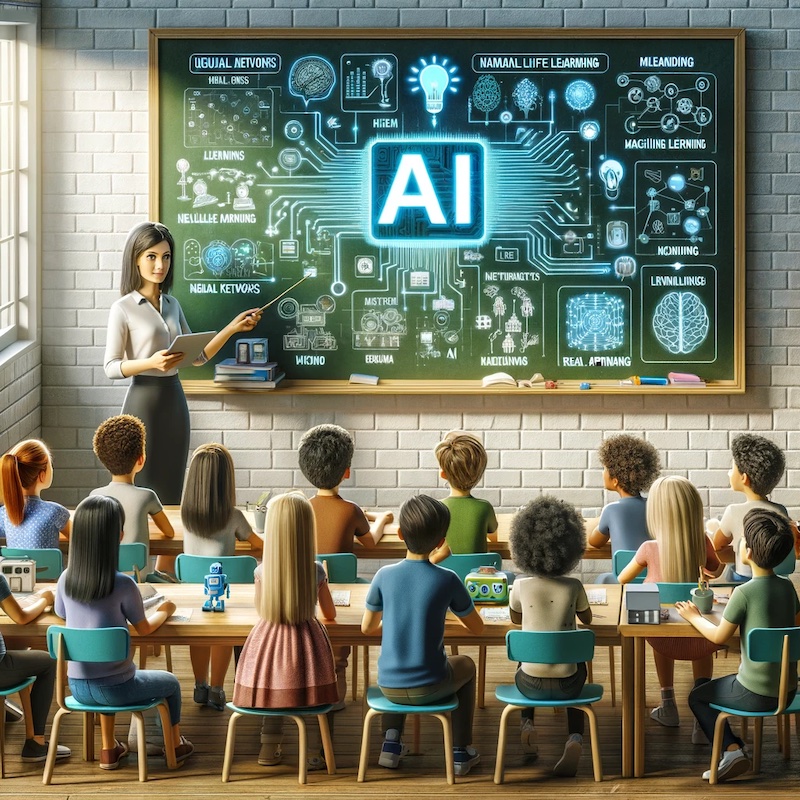Understanding and Accessibility: The Heart of AI Education
I got into AI accidentally. It had nothing to do with ChatGPT, and everything to do with the desire to clone myself because there weren’t enough hours in a day if I wanted to spend quality time with all of my students.
I found myself taking courses on how to grade better, as I needed to figure out how I could reclaim my weekends and not spend the wee hours of the morning writing feedback on essays. Because at the end of the day, at the rate I was going with my checking, no matter how many hours I poured into it, by the time my students received it, their attention had moved on to the next hard or shiny thing.
So what did I do? I started looking for ways to automate my workflow while ensuring the warmth and depth of the feedback I gave. My first code was written because I wanted to send personalized feedback without succumbing to clicking fatigue. Everything was sent from one spreadsheet.
That was in 2020. Interestingly, that was just the beginning, as it opened up a whole new world to me due to automation and technology. Suddenly, I found myself in the world of machine learning, neural networks, and data analytics. I barely understood anything; all I knew was that this was where the money was. Tired teachers were considering it as a career option.
By then it was 2021, and it was all too complicated for a teacher who was not tech-savvy. So, I spent a year leisurely saving articles that I knew I would not give time to understand.
Then came ChatGPT in November of 2022, and the world changed.
By then, I had realized that the Age of Artificial Intelligence had dawned. There was no way I was going to say things were too complicated and that I was not a tech person. I was now living in the future I had avoided because it sounded too complex for the MS Paint master that I was.
There was no excuse not to learn what I had deemed too complex for me. ChatGPT had the ability to help me understand the jargon I once found too intimidating. It made worlds I never dreamt of understanding accessible.
It is perhaps our curse and gift to be at the forefront of all this change—we just survived navigating the pandemic at school when ChatGPT arrived. While it can be a thankless and tiring job, teaching allows us to directly help the next generations succeed. And this is why I believe it is so crucial for us not to shun AI, but to be part of the pioneers who shape it. Yes, there is a lot to fear, especially at these early stages where we know little of what’s next and who’s behind what, but we must ensure that AI is a force for good.
If we ourselves struggle to understand or access AI, how can we truly accompany and assist our students, for whom AI is both a present reality and a future certainty?
If we want to prepare our students for the uncertainties of tomorrow, we must demystify AI now. And that starts with having conversations.
Why AI Literacy Matters Now More Than Ever
Let’s consider this statistic from a 2023 McKinsey Report:
“By 2030, activities that account for up to 30 percent of hours currently worked across the US economy could be automated—a trend accelerated by generative AI. However, we see generative AI enhancing the way STEM, creative, and business and legal professionals work rather than eliminating a significant number of jobs outright.”
With 2030 just 6 years away, some of our high schoolers would have graduated from college by then, or some would be in college. Other than those in the workforce now, they will be the first of our students who will be affected.
If 30% of work hours could be automated, and our students are trained in skills susceptible to automation, what implications does that hold for their future?
Or let’s consider it from another angle: if those in the STEM, creative, and business and legal industries find generative AI useful, how are we helping them now?
Are the assessments we’re giving, the skills we’re teaching, and the knowledge we’re imparting now useful for a future that requires less rote work and more creativity?
This is where AI literacy comes in.
Apart from critical thinking, which we have already built into our curricula, we need to equip our students with the vocabulary, concepts, and skills necessary to navigate the digital age.
Five-year-olds don’t need to learn what machine learning is, nor will 17-year-olds (unless they choose to), but what they do need to learn is what patterns are and what one can do with patterns.
We have to talk to our children. Talk to them in school, talk to them at home. Let them explore what they’re curious about.
Ask them “So what?” in all its iterations. So what happens if they notice a pattern? So what if the pattern means something? So what can be done with what they’ve found?
AI literacy will be the foundational knowledge that will prepare our students for a future beyond our foresight. We won’t know what AI will look like in 7 years. In fact, it might change 2 days from now, or OpenAI could release a new feature an hour from now.
Everything we know now will become obsolete sooner or later, so we need to help our students help themselves by building the intangible things that last.
The Immediate Relevance of AI in Classrooms
There’s a lot of good happening with AI in the classroom.
Significant progress in AI allow for helpful diagnoses like the app Soapbox, which is “powering dyslexia screening with speech technology”.
Other apps personalize learning, like Socrat.ai, which “engages your students in a Socratic dialogue” with a chatbot.
Not to mention, we’ve got some AI tools for you on Pedagog.ai to help streamline your workflow—whether it be for curricular, professional development, or administrative purposes.
Perhaps what needs to be addressed is the hesitation that comes with navigating the constant change we find ourselves dealing with.
The Educator’s Responsibility in AI Integration
The key responsibilities of educators in integrating AI into education are to do it purposefully, cautiously, and optimistically.
Purposefully: Before the whats and hows, always ask yourself: Why? If you are to bring any tool to your classroom, or use any of it for your workflow, always question its purpose. If it is just to be the next shiny object, then it’s best to focus your energies elsewhere.
Cautiously: Integrate slowly but surely. Check your school and district policies. Consider data privacy and security.
Optimistically: Our students need us to try now. AI is developing at such a rapid pace that hesitating to try it for just a few months means you might feel like your lightyears behind. If you fear certain consequences, rightly so, the very least you could do as a teacher would be to familiarize yourself with the terminology and landscape. Build your vocabulary and intuition for AI, so that when the time comes and you’re ready, you can hit the ground running with your students. Running the race doesn’t mean everyone’s on the same pace. It’s okay to pace yourself, too.
It doesn’t have to be scary. It can start with curiosity that leads to conversations. These conversations don’t have to be intimidating.
It’s okay to admit that you yourself are learning alongside your students.
In fact, your honesty will be most appreciated.
Whatever you decide on, start now.
Tackling the Challenge of Simplifying AI
We have an entire series of posts on social media designed to walk you through how to talk to your students about artificial intelligence, how to explain chatbots, etc. They’re written for teachers with all levels of AI experience in mind. Check out those posts, as well as our series on using analogies to explain AI.
Make it hands-on, do show-and-tells, and have students speak to ChatGPT with you. Do things together. You don’t need to have a computer science teacher with you the whole time.
Last but not least, you don’t even need to talk about AI terminology at times. Sometimes it’s about teaching them skills that they will need so that they can deal with these machines. Help them give clear instructions. Practice following directions. Teach them how to clarify when they’re unsure. Show them how to question questions and question answers.
So What? The Significance of AI Literacy
Most of the funding for anything AI-related is going to business, healthcare, and governments. Understandably so, as these are the industries that have the money to invest, and the industries that need and want to make the money back and more. They’re focused on their bottom line now.
But the bottom line of world economies involves training the generations now.
And that’s where we, the teachers, come in.
Unfortunately, ours is a role often taken for granted, but it is the backbone of the future.
Companies are spending billions trying to upskill their people now for the changes happening.
So, what happens when the first batch of graduates arrives? Would they be expected to know what those who have upskilled learned? Would it have been a waste if what we taught them years back prepared them for the past we are masters of, but not the future they will live in?
Now What? Actionable Steps for Educators
Immediate Actions to Take
- Integrate AI into the Curriculum: Begin with the basics of AI in current subjects. Use real-world AI applications to make lessons tangible.
- Facilitate Ethical AI Discussions: Create a platform for debating AI ethics. Encourage students to contemplate AI’s societal impact.
- Invest in Professional Development: Stay abreast of AI advancements. Seek out educational opportunities in AI.
Long-Term Strategies
- Encourage Hands-On AI Projects: Get students involved with AI tools and their practical uses. Discuss the pros and cons of AI technologies.
- Community Engagement: Educate parents and communities on the importance of AI literacy. Host events to broaden AI understanding.
- Promote Continuous Learning: Foster an environment where learning about AI is ongoing. Highlight that AI is a constantly evolving field.
Embracing Our Role in the AI Era I got into AI accidentally, but you don’t have to.
I hope you start with it intentionally.
You’ve got ChatGPT, Claude, Bard Gemini, Perplexity.ai, and all the other apps at your disposal now. Brainstorm with these chatbots on how you can streamline your workflow, improve your teaching methodologies, consider ideas you’ve never thought of before, and deepen engagement with students.
Use it. Enjoy it fearlessly and shape our future purposefully, for good. Start today!





